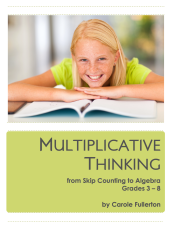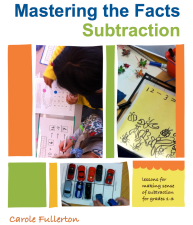Print Resources for Teaching Number Sense
 For those of you who have been looking for some of the teacher resources and student materials that I have used in my demonstration lessons, I’ve opted to try and put a collection of them all in one post… This collection of materials are intended for teaching place value, for use in lessons involving partitioning (addition, subtraction and multiplication), for comparing and ordering whole numbers as well as decimals, and for the teaching of fractions. As you’ve seen modelled in the lessons I’ve taught, these materials work best in concert with visuals (ten frames, base ten blocks, etc) and with plenty of opportunities for students to write equations, describe their thinking orally, build with models and create real-world situations to match.
For those of you who have been looking for some of the teacher resources and student materials that I have used in my demonstration lessons, I’ve opted to try and put a collection of them all in one post… This collection of materials are intended for teaching place value, for use in lessons involving partitioning (addition, subtraction and multiplication), for comparing and ordering whole numbers as well as decimals, and for the teaching of fractions. As you’ve seen modelled in the lessons I’ve taught, these materials work best in concert with visuals (ten frames, base ten blocks, etc) and with plenty of opportunities for students to write equations, describe their thinking orally, build with models and create real-world situations to match.
The money and Cuisenaire Rods are best printed in colour, of course. I’d recommend sending the pdf’s to Staples.ca for printing. You can specify the weight of the paper (I like 80lb gloss cover) – and they’ll have the materials ready quickly for a reasonable price.
Consider putting magnetic tape on the back of these materials to allow them to be displayed on the white board. Check out the dispenser of magnetic tape available from Poster Pals. It’s great stuff!
I hope these prove helpful.
Happy teaching!
Carole
Place Value Tents – 100’s 10’s 1’s
Canadian 100 dollar bills large
Canadian 10 dollar bills large
Canadian loonies in ten frames
The “What Do They Know” Assessment for Gr 2 & 2/3
 Sandra Ball and I have been at it again!
Sandra Ball and I have been at it again!
We have just put the finishing touches on another assessment tool for use in fall of the year. It’s a companion to the other “What Do They Know” assessments featured above, but are designed for students in grade 2 and 3.
Focussed on place value, partitioning and skip counting, this tool highlights number sense and the operations. The tool is administered by the classroom teacher and involves the whole class and small groups.
If you’re interested in piloting these materials, please go to my online store (https://mindfull.ecwid.com) and click on the FREE DOWNLOADS icon.
I hope it proves helpful to you in getting to know your learners and what they’re truly capable of!
Carole
Missing Part Cards – Laying the Foundation for Subtraction
Hello all!
 I had the pleasure of working with K and K/1 teachers in Mission on Monday – a great group of teachers who somehow managed to summon up the energy to attend an after-school workshop with me this week!! Together we looked at ways to support their young students in subitizing and partitioning. Sounds complex, doesn’t it? 🙂 Truth is, children in early primary need opportunities to see numbers at a glance without counting (subtizing) and to recognize that we can break up sets and put them back together again and the set size is the same (partitioning). These concepts and skills are critically important for young children to develop – they underpin the ability to add and subtract, to multiply and divide…
I had the pleasure of working with K and K/1 teachers in Mission on Monday – a great group of teachers who somehow managed to summon up the energy to attend an after-school workshop with me this week!! Together we looked at ways to support their young students in subitizing and partitioning. Sounds complex, doesn’t it? 🙂 Truth is, children in early primary need opportunities to see numbers at a glance without counting (subtizing) and to recognize that we can break up sets and put them back together again and the set size is the same (partitioning). These concepts and skills are critically important for young children to develop – they underpin the ability to add and subtract, to multiply and divide…
Engaging young children in conversations about how they “see” sets of number is a great way to start. Present an arrangement of 5-8 objects in your daily opening activities, and ask children what they see and how they see it. Talk about the parts and label these smaller sets with numerals to make sense of the digits. Celebrate the fact that, no matter how you slice it, 7 is still 7!
Over time, you might want to make connections to the operations by using the attached “Missing Part Cards”. They include a numeral to indicate the set size, and then dots in familiar arrangements in the form of an equation. The important part of course is to cover up just one of the sets of dots before showing the missing part cards to the children! 🙂 A 6.5 cm x 6.5 cm square of thick paper (bond paper or construction paper – or even sticky notes doubled up) taped across the top creates a flap that will hide one of the parts from view, as indicated below.

Show the card and read it aloud with the children:
“Seven is the same as 4 and…?”
It’s a good idea to say “is the same as” and “and” for “equals” and “plus” here. “Equals” and “plus” are the names for the symbols and are less meaningful to learners than “is the same as” and “and” – which are words that describe what the symbols mean…
Have students say what they think is missing, and why they think so. You’ll be surprised at the strategies students will use to find the missing part! Older learners will benefit from seeing the equation written with a box to indicate the missing part – that is,

This is a great way to introduce algebraic thinking in a visual way!!
Feel free to download the Missing Part Cards for 5, Missing Part Cards for 6 and Missing Part Cards for 7 here. They are best printed in colour of course, and will hold up best if printed on card stock or bond paper. Credit for the idea goes to John Van de Walle, who first showed them to me years ago. A smart man, our John – and one I miss terribly.

Enjoy!
Carole
PS – If you’re looking for more ideas like this for K and grade 1, consider purchasing a copy of my book: Number Sense – A Combined Grades Resource for K, K/1 and Grade 1 Math Classrooms. It’s set up to support teachers in addressing the number PLOs in mindful ways while keeping their Kindergarten and Grade 1 students together. Games, tasks, problems and meaningful practice opportunities are included in English and in French. To order online, click here.







